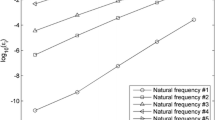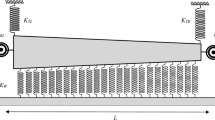Abstract
This paper investigates the performance of a novel global collocation method for the eigenvalue analysis of freely vibrated elastic structures when either basis or shape functions are used to approximate the displacement field. Although the methodology is generally applicable, numerical results are presented only for rods in which one-dimensional basis functions in the form of a power series, as well as equivalent Lagrange, Bernstein or Chebyshev polynomials are used. The new feature of the proposed methodology is that it can deal with any type of boundary conditions; therefore, the cases of two Dirichlet as well as one Dirichlet and one Neumann condition were successfully treated. The basic finding of this work is that all these polynomials lead to results identical to those obtained by the power series expansion; therefore, the solution depends on the position of the collocation points only.
Similar content being viewed by others
References
Carey G.F. and Oden J.T. (1983). Finite Elements: A second course, Vol II. Prentice-Hall, Englewoods Cliffs
Çelik I. (2005). Approximate calculation of eigenvalues with the method of weighted residuals-collocation method. Appl. Math. Comput. 160: 401–410
Cottrell J.A., Reali A., Bazilevs Y. and Hughes T.J.R. (2006). Isogeometric analysis of structural vibrations. Comput. Methods Appl. Mech. Eng. 195: 5257–5296
Craig R.R. and Bampton M.C.C. (1968). Coupling of sub-structures for dynamic analysis. AIAA J. 6: 1313–1319
De Boor C. and Swartz B. (1973). Collocation at Gaussian points. SIAM J. Numer. Anal. 10: 582–606
Den Hartog J.P. (1985). Mechanical Vibrations. Dover, New York
Finlayson B.A. (1972). The Method of Weighted Residuals and Variational Principles. Academic, New York
Gottlieb, D., Orszag, S.A.: Numerical Analysis of Spectral Methods: Theory and Applications, CBMS-NSF Regional Conference Series in Applied Mathematics, Vol.26, SIAM, Philadelphia, Pennsylvania (ISBN 0-89871-023-5) (1977)
Guyan R.J. (1965). Reduction of stiffness and mass matrices. AIAA J. 3: 380
Hughes T.J.R., Cottrell J.A. and Bazilevs Y. (2005). Isogeometric analysis: CAD, finite elements, NURBS, exact geometry and mesh refinement. Comput. Methods Appl. Mech. Eng. 194: 4135–4195
Inoue K., Kikuchi Y. and Masuyama T. (2005). A NURBS finite element method for product shape design. J. Eng. Des. 16(2): 157–174
Irons B.M. (1965). Structural eigenvalue problems-elimination of unwanted variables. AIAA J. 3: 961–962
Lapidus L. and Pinder G.F. (1999). Numerical Solution of Differential Equations in Science and Engineering. Wiley, New York
Mote C.D. (1971). Local-global finite element. Int. J. Numer. Methods Eng. 3: 565–574
Piegl L. and Tiller W. (1999). The NURBS Book, 2nd edn. Springer, Berlin
Press W.H., Flannery B.P., Teukolsky S.A. and Vetterling W.T. (1989). Numerical Recipes. Cambridge University Press, Cambridge
Provatidis C.G. (2006). Free vibration analysis of two-dimensional structures using Coons-patch macroelements. Finite Elem. Anal. Des. 42(6): 518–531
Provatidis C.G. (2006). Transient elastodynamic analysis of two-dimensional structures using Coons-patch macroelements. Int. J. Solids Struct. 43(22–23): 6688–6706
Provatidis C.G. (2006). Three-dimensional Coons’ macroelements: application to eigenvalue and scalar wave propagation problems. Int. J. Numer. Methods Eng. 65(1): 111–134
Rayleigh, J.W.S.: The Theory of Sound, Vols. 1 and 2. Dover, New York (enlarged from 1894 edition) (1945)
Schramm U. and Pilkey W.D. (1993). The coupling of geometric descriptions and finite element using NURBS—a study in shape optimization. Finite Elem. Anal. Des. 15: 11–34
Stroud A.H. and Secrest D. (1966). Gaussian Quadrature Formulas. Prentice-Hall, London
Szabó, B.A., Babuška, I.: Finite Element Analysis. Wiley, New York (1991)
Zienkiewicz O.C. (1977). The Finite Element Method, 3rd edn. McGraw-Hill, London
Author information
Authors and Affiliations
Corresponding author
Rights and permissions
About this article
Cite this article
Provatidis, C.G. Free vibration analysis of elastic rods using global collocation. Arch Appl Mech 78, 241–250 (2008). https://doi.org/10.1007/s00419-007-0159-4
Received:
Accepted:
Published:
Issue Date:
DOI: https://doi.org/10.1007/s00419-007-0159-4




